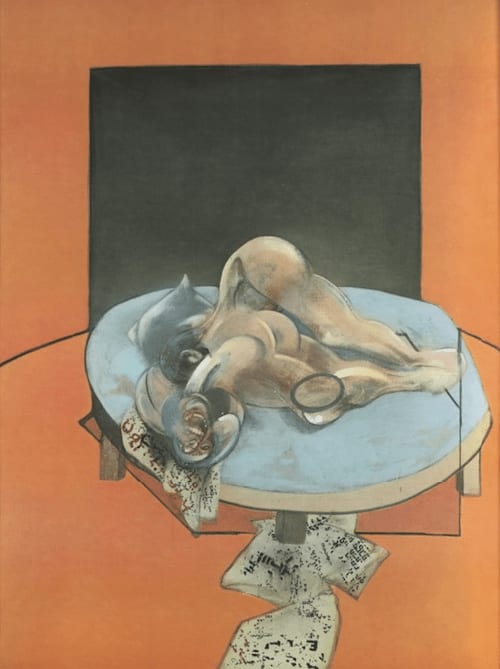
Francis Bacon
101.5 x 66 cm
Studies of the Human Body , after the Central Panel of the Triptych Studies of the Human Body 1979, 1980 by Francis Bacon offers a deeply introspective and haunting vision of the self, continuing a powerful trajectory of self-portraiture that became a central focus of his later career—particularly throughout the 1970s and 1980s. During this period, Bacon increasingly turned inward, grappling with themes of ageing, mortality, and psychological isolation. This work exemplifies that shift, presenting a fragmented, emotionally charged reflection of the artist’s inner world rather than a traditional likeness.
Bacon’s figure is seated in an unnaturally twisted pose, embodying both physical discomfort and emotional strain. The head—distorted, deformed, and partly disintegrated—appears to collapse in on itself, dissolving the boundaries between flesh and space. This manipulation of anatomy, a signature of Bacon’s visual language, conveys not only the vulnerability of the human body but also the instability of identity itself. The face is not rendered for recognition; rather, it is constructed as a psychological battleground, where anguish, memory, and self-doubt converge.
The surrounding environment reinforces this emotional isolation. The figure is set against a stark, minimalist backdrop of pale blue and sandy beige, tones that evoke both calm and clinical detachment. The emptiness of the space accentuates the solitude of the figure, stripping away any contextual markers that might suggest comfort or connection. Instead, the sparse setting heightens the sense of psychological exposure. A single diagonal line cuts across the composition, dividing floor from wall with surgical precision. This sharp geometric intrusion adds to the disorienting atmosphere, reinforcing a feeling of confinement, as if the figure exists in a space between dimensions—neither fully grounded nor entirely free.
Bacon’s palette is subdued yet calculated. The soft, cool hues of the background are contrasted with the dark, bruised tones of the figure’s body. This juxtaposition underscores one of the key tensions in the work: the contrast between outward composure and inner turmoil. The placid setting might suggest stillness or peace, but the distorted form disrupts any sense of serenity. This interplay between external calm and internal chaos is a recurring motif in Bacon’s self-portraits, capturing the psychological contradictions that define human existence.
By the 1980s, Bacon was acutely aware of his own mortality. Many close friends and lovers, including George Dyer—whose suicide in 1971 deeply scarred Bacon—had died, leaving the artist increasingly isolated. This emotional solitude echoes throughout After Study for Self-Portrait, not only in its formal composition but in its existential tone. The work does not seek to immortalize the artist through idealization; rather, it confronts the decay and fragility of the self with brutal honesty. The figure appears not as a coherent whole but as a fragmented, fading presence—a body and identity under siege.
More than a self-portrait, this piece functions as a psychological excavation. Bacon uses the language of distortion, abstraction, and isolation to articulate profound human fears: the fear of ageing, the fear of death, and the fear of dissolving into irrelevance. There is no vanity here, no search for legacy—only the raw confrontation with impermanence. In doing so, Bacon turns the act of self-portraiture into a theatre of existential reckoning.
Ultimately, After Study for Self-Portrait stands as a poignant reflection on the artist’s late style: a culmination of decades spent dissecting the body, emotion, and identity. It captures not only Bacon’s unique visual language but also his enduring preoccupation with the unstable nature of selfhood. This work, like others in his later self-portraits, transcends biographical specificity to become a universal meditation on what it means to exist—to endure the erosion of time, to confront oneself in isolation, and to find meaning in the fractured mirror of the human condition.
For more information on Francis Bacon’s Studies of the Human Body , after the Central Panel of the Triptych Studies of the Human Body 1979, 1980 or to buy Francis Bacon’s Studies of the Human Body , after the Central Panel of the Triptych Studies of the Human Body 1979, 1980 contact our galleries using the form below.